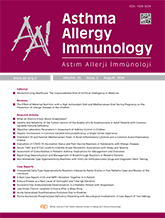


Objective: To evaluate the characteristics of non-immediate type hypersensitivity reactions with first-line antituberculosis drugs and determine the causative drugs by patch tests and drug provocation tests.
Materials and Methods: Baseline data including patients` demographics, disease characteristics, and drug hypersensitivity reaction characteristics were recorded. Patch testing was performed with all the drugs used during hypersensitivity reaction at 1/10 and 1/1 concentrations. Drug provocation tests were performed at 3-day intervals with drugs that had negative patch test results.
Results: A total of 32 patients were included in the study. The clinical phenotype was maculopapular eruption in 11(34.4%), dermatitis in 10 (31.3%), drug reaction with eosinophilia and systemic symptoms in 1 (3.1%), and Stevens-Johnson syndrome/Toxic epidermal necrolysis in 10 (31.3%) patients. Combination therapy during the index reaction consisted of isoniazid (H), rifampicin (R), pyrazinamide (Z), and ethambutol (E) in 28 (87.5%) patients, Patch tests were performed with 95 drugs consisting of 25 H, 25 R, 21 Z, and 24 E in 25 patients. Results were positive in 8 patients with 10 drugs: 8 (32%) H, 1 (4%) R, and 1 (4.2%) E positivity were detected. Drug provocation tests were performed with 78 drugs (18 H, 23 R, 15 Z, 22 E) in 25 patients and resulted positive with H, R, Z, and E in 16.7% (3 of 18), 21.7% (5 of 23), 46.7% (7 of 15), and 54.5% (12 of 22) of the patients respectively. Negative predictive values of patch tests with H, R, Z, and E were calculated as 87.5% (14/16), 81.8% (18/22), 50% (7/14), and 45% (9/20) respectively. According to the results of the patch tests and provocation tests, the most common culprit of hypersensitivity reactions was found to be E (n=12), followed by H (n=10). Multiple drug hypersensitivity was detected in 9 of 23 (39.1%) patients.
Conclusion: Patch testing is useful in the management of non-immediate type hypersensitivity with first-line antituberculosis drugs. However, further studies are needed to determine its predictive value